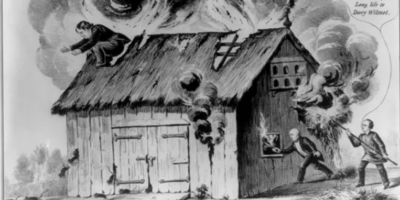The familiar Castro
By Beth Connors-Manke
You’re looking and looking at something for years. Eyes wide as they can be, waiting for the equation, or picture in the puzzle, or the kaleidoscope pieces to fall into place. So the problem can be resolved, so your life can move on. So that you can look at something else.
***
My husband usually doesn’t wake me up for breaking news. But there he was, beside the bed saying things my groggy mind couldn’t quite tie together: “Amanda Berry,” “Cleveland,” “found.” Nonetheless, before I went back to sleep, I did register one thing: he felt connected to the story.
All three women held by Ariel Castro disappeared after my husband and I had moved away from Cleveland: Michelle Knight in 2002, Amanda Berry in 2003, and Gina DeJesus in 2004. We were gone, so their disappearances weren’t stories that we woke up to every morning in the Cleveland Plain Dealer. But when the news broke on May 6, that didn’t seem to matter. My husband is a born Clevelander; he quickly placed the now infamous 2207 Seymour Avenue address; his father had grown up a few blocks away during the 1930s and 40s. The area of the abductions, near West 110th and Lorain Avenue, abutted my old neighborhood, where I walked the streets and took the bus. If nothing else, the geography of the story tied him to the Internet as events unfolded during that first week.
My connection was of a slightly different hue. The tale had all the puzzle pieces I’d been shuffling around for years—public streets, women, human trafficking, imprisonment—thrown together into one horrifying and badly sensationalized news story. My eyes were wide, and I could see the kaleidoscope shift into place, but I knew then that seeing the equation wasn’t going to solve anything.
***
You may not remember, but just after the girls were found and before the media was sure that only Castro was involved, there was mention of human trafficking. Some news outlets relayed that Nancy Ruiz, Gina DeJesus’ mother, initially believed (in 2004) that her daughter had been sold into sex trafficking. When I heard this, I thought to myself: even if this wasn’t legally human trafficking (which specifies that commercial gain is involved), surely it’s part of the same structure of thinking and acting. Stealing girls off the street and forcing them into captivity is, no doubt, a cousin to stealing girls off the street and selling them into captivity.
However, after Castro was arrested and basic information about the abductions was released, discussion about any structural causes fell quiet. No more human trafficking; very little mention of domestic violence. The Cleveland case was limned as an astonishing narrative of kidnapping, captivity, and rape. We had the daring Amanda Berry; the kooky hero, Charles Ramsey; and, of course, the villain, Ariel Castro.
It is Castro’s characterization that is the most dangerous to us. Castro, viewed as a moral monster with the ability to live undetected among decent folk. As National Public Radio (NPR) reported: “Many neighbors here say they’re frustrated and perplexed, some even ashamed that they never figured out that the missing women were being held here all along.” Maria Davila, a neighbor, told NPR: “It’s embarrassing for the community to have to deal with such a travesty. Like, such a monster, he was just out in public, and everyone saw him. We all knew him. And then all of a sudden, you know, we find out this.” This out-of-the-blue monster idea is the part of the story that obscures a bigger cultural economy that, at it’s worst, ends in the ten-year captivity and torture of women in a boarded up house in the middle of a city.
But isn’t Castro a monster? I don’t know—maybe. That’s a psychological question, and one that isolates his case, one that doesn’t leave us anywhere to go. If Castro is an inhuman monster, a creature outside our ken, then this is just a big, bizarre, highly tragic story. If we only indulge in the melodrama and ignore the broader structural factors then, as scholar Carol Vance argues, we “[misdirect] the eye from complexity and contradiction,” satisfied instead with “a simplified and emotionally gripping substitute.” In other words, we’re along for the sensational ride, but we’re not really seeing the equation, which is about privatization and removal of individuals from the public sphere. (More on privatization later.)
However, there was evidence here and there in the early reportage that makes Castro’s character a more familiar figure—someone bad, but not completely horrifying. According to an Associated Press story, after his first child was born, Castro began severely beating his common-law wife Grimilda Figueroa and eventually took to cutting off his wife and children from family and friends (not uncommon patterns in domestic violence). This included imprisoning them in the house (again, not uncommon in domestic violence). Figueroa lodged legal complaints, “accusing Castro of threatening many times to kill her and her daughters. She charged that he frequently abducted the children and kept them from her, even though she had full custody, with no visitation rights for Castro.”
The actions of this type of figure—a guy with “problems,” but still considered the guy next door who is allowed to drive a school bus—actually garner a reaction opposite of what happened after May 6 when the girls were found. With severe domestic violence, often friends, family, and neighbors look away, or make excuses for him, or blame her, or are scared enough that they do nothing. They don’t throw down their hamburgers and rush to break open a door. They mind their own business.
So maybe Castro isn’t as much of a psychological mystery as he seemed in our shock after hearing about the girls. Maybe he thinks the way some other people think. He was just bolder in translating thought into action.
For our own collective good, we have to continue to look at Castro, to make him familiar for two reasons. First, his type is already around us; we have to be able to imagine him in our public sphere and understand that he circulates in public spaces. Second, he’s representative of a structure of thought and action that we have to contend with, not just demonize. It’s a structure of thought that extends from human trafficking to the penal system to upper middle class neighborhood enclaves.
***
Knight, Berry, and DeJesus have been restored to their homes and are being shielded from media glare. They’re off stage again—for the moment at least. And Castro, he’s out of our view, except in the photos that have him hiding his face in the collar of his jumpsuit. But where are we? What do we now see?
In part two of her essay, Beth will try to discern how the privatization of spaces equates to the privatization of people. She’ll try to get a wider glimpse of the picture.




Leave a Reply